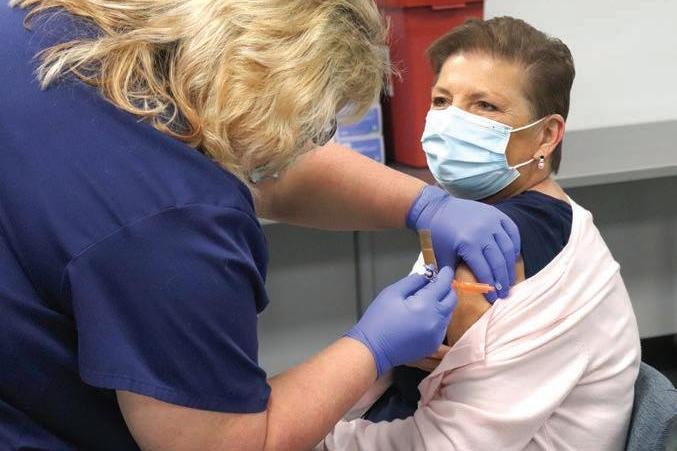
4 minute read
First COVID-19 vaccines make it to WNC
Haywood Regional Medical Center employees receive the first doses of COVID-19 vaccines. Donated photo
— g First COVID-19 vaccines y g make it to WNC
The COVID-19 vaccine distribution has begun in Western North Carolina with the first doses going to healthcare workers and emergency medical technicians and paramedics on the frontlines.
Haywood Regional Medical Center administered the first doses of the COVID-19 vaccine to its healthcare workers on Dec. 18.
Registered nurse Susan Wynne raised her hand to receive the first dose.
“I have said ever since we’ve talked about a COVID-19 vaccine that I wanted to be first in line, and they took me at my word,” she said. “They called me Tuesday to see if I was serious — I said absolutely. So here I am.”
When asked about the importance of the vaccine, for healthcare workers in particular, she said, “I think that we’re front line, we are [at risk of being] exposed and we need to slow the spread.”
Since that morning, others have opted f into taking the vaccine, including Emergency
Room and Intensive Care Unit workers on g the frontlines of COVID-19 patient care.
ER doctor Eric Zickerman said one of the reasons he’s taking the vaccine is to protect his family. “My wife’s not medical, and she’s thrilled that I’ll be more protected at work.
This is a big day,” he said.
“This has been an incredible team effort locally,” said HRMC CEO Greg Caples. “and
I want to commend our staff — for staying the course through the pandemic and now for helping this vaccination process run smoothly. It is a very exciting time for science, healthcare and our country.”
Vaccines will continue at Haywood
Regional Medical Center for employees, prioritizing as per guidance from the CDC, federal government, and the state of North Carolina.
This vaccine allotment is not available for the public at this time, but, once the vaccine becomes more broadly available, we will encourage our community to get vaccinated.
With the arrival of a vaccine, hope is on the horizon, but there is still a long road ahead to normal. Exact dates for distribution are not yet available, but a general timeline has been issued by the Haywood County Health Department.
Over the coming weeks and months, vaccinations will proceed as doses are allotted, in the following manner, according to the risk categories recommended by the CDC. The first groups will be the health care workers fighting COVID-19 and the long-term care facility residents who have been most vulnerable throughout the pandemic.
Doctors, nurses, and technicians who interact with patients will be administered vaccines at the hospitals. Long term care facility residents, those in nursing homes, and adult, family, and group homes will be administered by pharmacies at the facilities.
Adults at high risk of severe illness and those at highest risk of exposure will be next. This will include people with two or more chronic illnesses, such as heart disease, or diabetes.
Also in this group will be essential frontline workers, such as police, teachers, food processing workers, other health care workers, and those who live or work in prisons or homeless shelters.
Following the risk chart, the next group will be other adults at high risk who didn’t get into the previous groups, including adults over age 65, and adults with one chronic illness.
The next group will be students over the age of 16. The currently available vaccines are not yet approved for children under the age of 16. When that happens, they may also be included in this group.
Those employed in jobs that are critical to society and are at a lower risk of exposure will be eligible at this time. Lastly, the general public, anyone who has not yet been vaccinated and would like to will be able to participate after those at high risk have had access.
At each step of the way, the health department will provide updates and plenty of advance notice to make sure that everyone who wants to be vaccinated will have their chance.
Total Fat 0g Regional News Opinion Outdoors Arts Entertainment Classifieds
% Daily Value *
0% 100% 100% 100% 100% 100% 100%
* Percent Weekly values based on Haywood, Jackson, Macon, Swain and Buncombe diets. Crafted in Carolina Local Art & Jewelry Cheryl Danek’s ‘She Shed’ Ornaments, masks, holiday masks, corn hole bags & MUCH more!
828.944.0004 | 3073 Soco Rd | Maggie Valley Tuesday thru Saturday 10-5 craftedincarolina.net
Ingles Nutrition Notes written by Ingles Dietitian Leah McGrath

QUESTION: What is a 'sugar alcohol'? I see this listed on some sugar-free items I buy
ANSWER: Sugar alcohols, also known as "polyols", are a type of carbohydrate- that's why you see them listed under the CARBOHYDRATES section on a Nutrition Facts label. Sugar alcohols have a different chemical structure than a sugar, so your body does not process them or absorb them in the same way as it does sugar. Food makers often use sugar alcohols in sugar-free, no-sugar added or "keto" products as they lend sweetness but have fewer calories than sugar or other caloric sweeteners. This is often helpful for those seeking to reduce their caloric intake or intake of carbohydrates (sugar). There are many different kinds of sugar alcohols that you might frequently see listed in ingredients on sugar-free candy, cookies or sugar-free gum like mannitol, sorbitol, maltitol, and xylitol. Caution: Excess consumption of products with sugar alcohols can cause gastric (stomach/bowel) distress in some individuals!
Leah McGrath, RDN, LDN Ingles Market Corporate Dietitian @InglesDietitian Leah McGrath - Dietitian 800.334.4936











